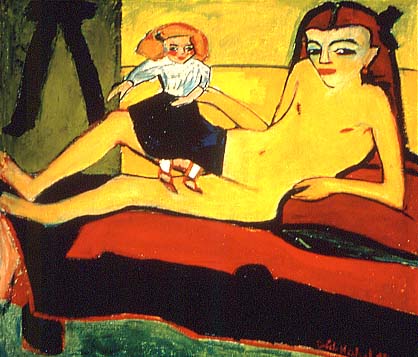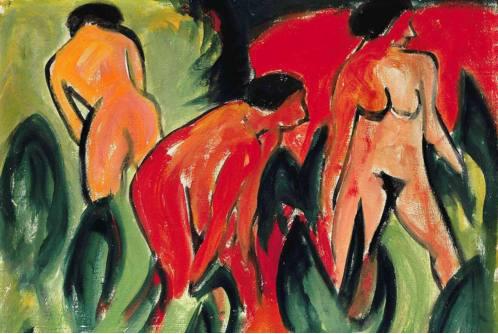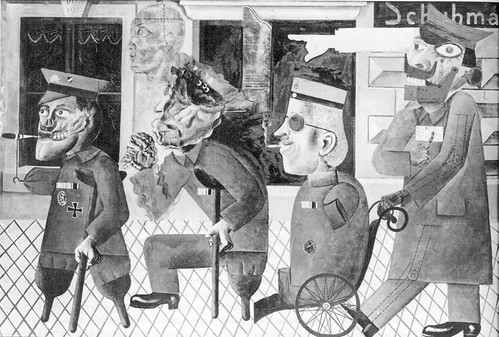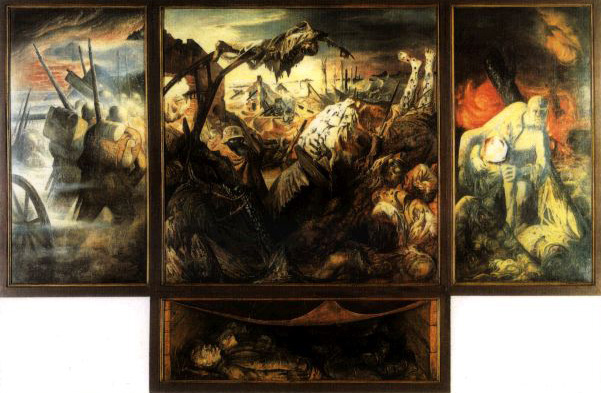Cards In This Set
| Front | Back |
 . |
Erich Heckel, Fränzi with Doll, 1910, expressionism, about 11, probs not sexually involved w/ artists but still provocative, doll covers vagina, sign of little girl but she poses provocatively, odalisque, skeptical and child-like vs sexual lolita, play of 2, pure emotion, not acting, raw, unposed
|
 . |
Ernst Ludwig Kirchner, Potsdamer Platz, 1914, 1 of first founders of Der Brucke, v crowded street of berlin, anxiety of coming to city from rural lands, city is dirty, dangerous, men lurking, infl by Munch
|
 . |
Karl Schmidt-Rottluff, Three Bathing Women, 1913, central woman has animalistic stance, primitivism, looks like gorilla, not feminine stance, melding of figure and nature and animal, violent red
|
 . |
Wassily Kandinsky, The Blue Rider (Blaue Reiter), 1903, main person of this art movement, says the name didn't stem from this painting, 1 of 4 horsemen, blue reps masculinity, infl by Monet
|
 . |
Wassily Kandinsky, Composition VII, 1913, v crowded, fauvist use of color, some cubist infl, art is supposed to guide you to happiness, common understanding, etc. color is most imp feature of that progress, no focal pt, eyes drawn everywhere, analogy for music, wants painting to have same effect on you as music, playful use of color and line
|
 . |
Franz Marc, Three Cats, 1913, does lots of images of animals, animals, infl by primitive art, interestedin getting closer to nature, move against modernity, lets you escape those anxieties of modern world, modern art like primitive art, both artists don’t have grasp of the world, modern artists equally confused like primitive artists, animal world like primitive world, use nature to understand better the world
|
 . |
Max Beckmann, Descent from the Cross, 1917 becomes infl by gothic work from northern renaissance, sees it during war, eerily positive effects, ideas of suffering and pain, body is skinand bones, extreme suffering, graphic, relates to suffering at the time ie black plague and war
|
 . |
George Grosz, A Victim of Society, 1919 lopsided eye, fake nose and lips, knife in neck, Dada collage of german, question mark on forehead, he doesn't know anything,
|
 . |
Otto Dix, War Cripples, 1919 there was a march in Paris, what war really looked like, anti-war efforts, captures new face of Germany, interest ingrotesque, ghostly figure arises out of 2nd man on left, perfect human body out of reach at this point, can’t depict ppl now as perfect
|
 , |
Otto Dix, The War, 1929-32 like church altarpiece/triptych, bottom usu is patrons in grave, but he uses it as soldiers in a grave, heroic soldierson side panels, dark, graphic, neutral palette
|
 , |
Kurt Schwitters, Construction for Noble Ladies, 1919 considered too bourgeois for Dadaists, not allowed, interested in formal elements, real wheel, uses trash, glued, nailed, etc. it's a Merz bilder- fragments, merz comes from torn paper about Commerz Bank, play of materials
|
 , |
Kurt Schwitters, photograph of the Merzbau, 1923-37 it's his home, functional, Hanover, installation art now, total artwork, infl by Wagner, immersive experience, left urine, etc throughout house, melding of body and building
|
 , |
Max Ernst, The Hat Makes the Man, 1920 phallic towers, hat=bourgeois man, penis makes the man, studies art from insane asylums, dada and surrealist
|
 , |
Otto Dix, Portrait of the Dancer Anita Berber, 1925, neue sachlichkeit, 1923 term coined, grim reality of Weimar germany, uglified, v famous in berlin, danced nude, ironic she's in a full dress, alcoholic, lots of coke, looks aged, seduced men and women, can't tell based on this portrait
|
 , |
George Grosz, Street Scene (Kurfürstendamm), 1925, like a caricature, infl by Manet in terms of content, everyday street scene, war vet vs man w/ cane as fashion statement, he doesn't need it, ignores the vet, everyone looks away from him, dressed nicely
|



